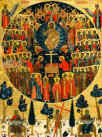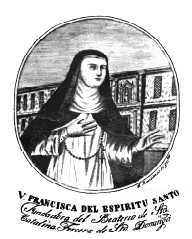|
Philippine Saints
The saint's cult was and is wide spread on the Philippines. Poor people need many saints ", a saying states mockingly and this is true with regard to the Philippines. For centuries however the Philippine Catholic believers did not have any "national" saint. Candles and prayers were dedicated to "imported" heroes of belief. But now when more and more believers slip away from the Catholic Church - the Church seems to diversify their religious marketing since the eighties by discovering "national" saints. Their earthly life should be introduced here shortly - without any mission claim. It concerns a canonized saint (Lorenzo Luis), a blessed or beatificated saint (Pedro Calungsod) and a person which is a candidate for saint hood (Francisca del Espiritu Santo).
The relatively peaceful life is interrupted abruptly when he is "implicated" 1636 in a murder case. His ecclesiastical superiors are convinced of his innocence; however, they fear strangely enough - an unjust prosecution for their protégé and press him to join to a missionary's expedition. First he thinks that Taiwan would be the destination of the mission. But the mission goes to Japan. At that time, there was only little knowledge about the mysterious country of Japan; anyhow there have been reports on persecutions of Christians. Arrived the small mission group is immediately taken into custody in Nagasaki in September 1637. First tortures use it to persuade it of the faith turning back. Nails were driven under his nails and the prisoner has to drink gallons of water. Lorenzo Luis, however, doesn't revoke. He is supposed to have said: "I am a Catholic and happy to die for God. If I have a thousand lives to offer, I will offer tem to God". He is offered a safe return to the Philippines last, but Lorenzo Luis remains stable in his faith. Finally they hanged him headfirst into a well after they had slit his temples. After three days, eight days after his arrival in Japan, he dies. His body is burned after the cruel torture and the ashes are thrown into the sea. 350 years after his death in 1981 he is beatified by Pope Johannes Paul II on occasion of his visit of the Philippines. Lorenzo Luis is the first Philippine Saint. The canonization as saint follows in 1987 by the same pope. Lorenzos beatification was the first one which took place outside the Vatican. The canonization has as prerequisites "virtues of heroic extent" and at least two authenticated "miracles", which happened in his name. We do not know which "miracles" the defenders of canonization put forward. But it cannot be denied that Lorenzo fought and died for his faith. Luis is regarded as a patron saint of the Philippine youth, the Chinese sturdy Filipinos, the Philippine workers working abroad and the poor.
Nevertheless baptisms took place without consent of the parents. So the two chieftains induced to attack the mission group with spears. Pedro Calungsod would have been able to flee, but he stands by his supervisor Luis Vitores. A spear pierced his chest, he fells to the ground and a machete breached his skull. His supervisor is killed in the same way. The two maltreated bodies were tied, burdened with a stone and thrown into the sea. It is told that Pedro Calungsod was only seventeen to eighteen years old at his death in 1672. His supervisor Vitores was beatificated in 1985. The beatification of his squire Pedro Calungsod follows in 2000 in a solemn ceremony in Rome. Ex-president Estrada and wife are attending the ceremony while the church bells are ringing on Cebu. The title "Blessed" makes Pedro Calungsod a candidate for sainthood. The martyr is celebrated as "truly Filipino" and a "great soldier of Christ". In December 2011 the Holy Seat approved a miracle, qualifying Calungsod to become a saint. Pope Benedikt XVI canonized Calungsod as Saint, in October 2012.
At the end a little joke showing that the Saints are sometimes in farer distance. A tourist visiting a church asked once a Filipino: "Do you also have a patron saint, a Santo, here? " The Filipino answered: "No, we don't have a Santo here, but many Santoses (1) ". (1) Persons with the name "Santos" © Wolfgang Bethge, 2004 |
 While
the relatively abstract theology of the reformed Christian churches knows
no inter-authority between "heaven" and "earth" with mediators, the
Catholic heaven is populated with more than 1800 saints -
earthly-transcendental figures to which the believers can turn with pleas.
The saints testify and demonstrate in an obvious way religious faith and
demonstration has always been a key strategy for the Catholic Church.
While
the relatively abstract theology of the reformed Christian churches knows
no inter-authority between "heaven" and "earth" with mediators, the
Catholic heaven is populated with more than 1800 saints -
earthly-transcendental figures to which the believers can turn with pleas.
The saints testify and demonstrate in an obvious way religious faith and
demonstration has always been a key strategy for the Catholic Church.
 Lorenzo
Luis was born around 1600 in an outside-district of Manila. His mother
came from Tagalag; the father was of Chinese descent. Lorenzo was talented
exceptionally; the Dominicans engaged him as calligrapher. In this
layman's function he was responsible for the registration of baptisms,
confirmations and weddings in the official church registers. Luis joined a
Marian confraternity and was regarded as trustworthy. He got married later
and had three children.
Lorenzo
Luis was born around 1600 in an outside-district of Manila. His mother
came from Tagalag; the father was of Chinese descent. Lorenzo was talented
exceptionally; the Dominicans engaged him as calligrapher. In this
layman's function he was responsible for the registration of baptisms,
confirmations and weddings in the official church registers. Luis joined a
Marian confraternity and was regarded as trustworthy. He got married later
and had three children.  There is
only little information about the second Philippine Saint - Pedro
Calungsod. He is born in Visayas - presumable on Cebu. 1668 be becomes
a catechist (layman helper). A few years later in the young age of 14
years he follows a mission group
led by Jesuits. The mission group goes to the island of Guam in order to
convert pagans to the Roman Catholic faith. But the local chiefs Matapang
and Hirao oppose the baptism of babies and faith instruction of their children.
There is
only little information about the second Philippine Saint - Pedro
Calungsod. He is born in Visayas - presumable on Cebu. 1668 be becomes
a catechist (layman helper). A few years later in the young age of 14
years he follows a mission group
led by Jesuits. The mission group goes to the island of Guam in order to
convert pagans to the Roman Catholic faith. But the local chiefs Matapang
and Hirao oppose the baptism of babies and faith instruction of their children. Another person is still a candidate for beatification - it is Mother
Francisca Del Espiritu Santo. She was born 1647 in Manila. After her
marriage she became early a widow early and she decided to lead a life in
pursuit of Christian virtues. She wanted to help the sick and needy
persons. In 1684 she founded together with three other women a religious
community following the faith principles of the Dominicans. The community
becomes later an institution and cares particularly about the education of
up growing girls, an objective relatively unknown at that time.
Franziska's congregation is presently still working with 270 sisters in
schools, numerous hospitals and in the mission field.
Another person is still a candidate for beatification - it is Mother
Francisca Del Espiritu Santo. She was born 1647 in Manila. After her
marriage she became early a widow early and she decided to lead a life in
pursuit of Christian virtues. She wanted to help the sick and needy
persons. In 1684 she founded together with three other women a religious
community following the faith principles of the Dominicans. The community
becomes later an institution and cares particularly about the education of
up growing girls, an objective relatively unknown at that time.
Franziska's congregation is presently still working with 270 sisters in
schools, numerous hospitals and in the mission field.